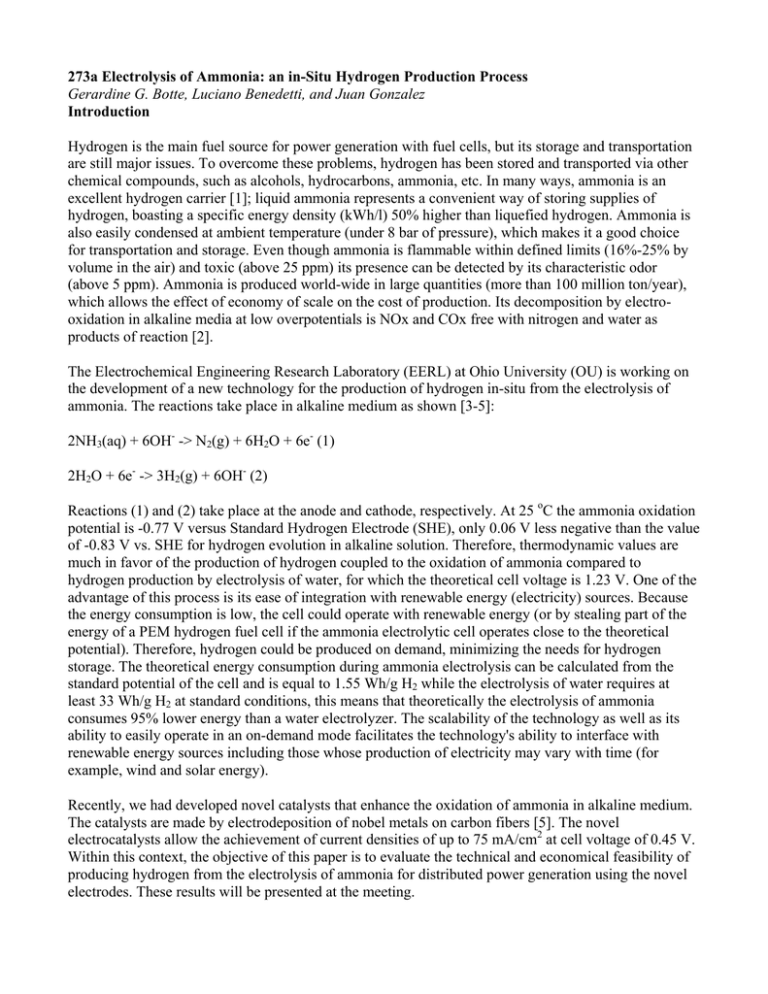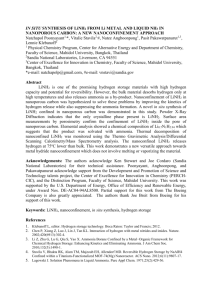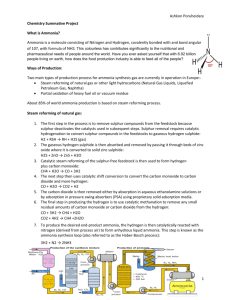273a Electrolysis of Ammonia: an in-Situ Hydrogen Production Process Introduction
advertisement

273a Electrolysis of Ammonia: an in-Situ Hydrogen Production Process Gerardine G. Botte, Luciano Benedetti, and Juan Gonzalez Introduction Hydrogen is the main fuel source for power generation with fuel cells, but its storage and transportation are still major issues. To overcome these problems, hydrogen has been stored and transported via other chemical compounds, such as alcohols, hydrocarbons, ammonia, etc. In many ways, ammonia is an excellent hydrogen carrier [1]; liquid ammonia represents a convenient way of storing supplies of hydrogen, boasting a specific energy density (kWh/l) 50% higher than liquefied hydrogen. Ammonia is also easily condensed at ambient temperature (under 8 bar of pressure), which makes it a good choice for transportation and storage. Even though ammonia is flammable within defined limits (16%-25% by volume in the air) and toxic (above 25 ppm) its presence can be detected by its characteristic odor (above 5 ppm). Ammonia is produced world-wide in large quantities (more than 100 million ton/year), which allows the effect of economy of scale on the cost of production. Its decomposition by electrooxidation in alkaline media at low overpotentials is NOx and COx free with nitrogen and water as products of reaction [2]. The Electrochemical Engineering Research Laboratory (EERL) at Ohio University (OU) is working on the development of a new technology for the production of hydrogen in-situ from the electrolysis of ammonia. The reactions take place in alkaline medium as shown [3-5]: 2NH3(aq) + 6OH- -> N2(g) + 6H2O + 6e- (1) 2H2O + 6e- -> 3H2(g) + 6OH- (2) Reactions (1) and (2) take place at the anode and cathode, respectively. At 25 oC the ammonia oxidation potential is -0.77 V versus Standard Hydrogen Electrode (SHE), only 0.06 V less negative than the value of -0.83 V vs. SHE for hydrogen evolution in alkaline solution. Therefore, thermodynamic values are much in favor of the production of hydrogen coupled to the oxidation of ammonia compared to hydrogen production by electrolysis of water, for which the theoretical cell voltage is 1.23 V. One of the advantage of this process is its ease of integration with renewable energy (electricity) sources. Because the energy consumption is low, the cell could operate with renewable energy (or by stealing part of the energy of a PEM hydrogen fuel cell if the ammonia electrolytic cell operates close to the theoretical potential). Therefore, hydrogen could be produced on demand, minimizing the needs for hydrogen storage. The theoretical energy consumption during ammonia electrolysis can be calculated from the standard potential of the cell and is equal to 1.55 Wh/g H2 while the electrolysis of water requires at least 33 Wh/g H2 at standard conditions, this means that theoretically the electrolysis of ammonia consumes 95% lower energy than a water electrolyzer. The scalability of the technology as well as its ability to easily operate in an on-demand mode facilitates the technology's ability to interface with renewable energy sources including those whose production of electricity may vary with time (for example, wind and solar energy). Recently, we had developed novel catalysts that enhance the oxidation of ammonia in alkaline medium. The catalysts are made by electrodeposition of nobel metals on carbon fibers [5]. The novel electrocatalysts allow the achievement of current densities of up to 75 mA/cm2 at cell voltage of 0.45 V. Within this context, the objective of this paper is to evaluate the technical and economical feasibility of producing hydrogen from the electrolysis of ammonia for distributed power generation using the novel electrodes. These results will be presented at the meeting. References 1. R. A. Wynveen, Fuel Cells 2, (1963) 153. 2. S. Wasmus, E. J. Vasini, M. Krausa, H. T. Mishima and W. Vielstich, Electrochimica Acta 39, (1994) 23. 3. F. Vitse, M. Cooper and G. G. Botte, J. Power Sources 142, (2005) 18. 4. G. G. Botte, F. Vitse and M. Cooper, "Electrocatalysts for the Oxidation of Ammonia and their Application to Hydrogen Production, Fuel Cells, Sensonrs, and Purification Processes", Pending Patent, (2003) US. 5. G. G. Botte, "Carbon fiber-electrocatalysts for the Oxidation of Ammonia, Ethanol, and Coal, and their Application to Hydrogen Production, Fuel Cells, and Purification Processes", Pending Patent, (2004) US.







